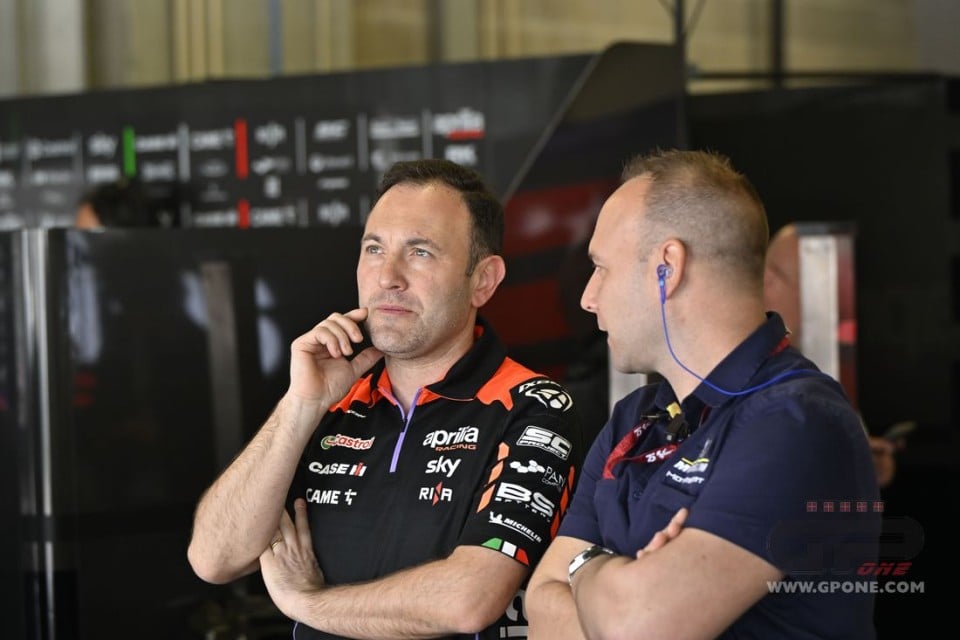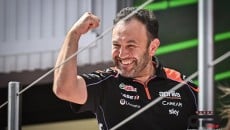A few days ago the guidelines of the MotoGP of the future were laid down. From 2027 there will be less powerful, simpler bikes on the track, with less aerodynamics and no lowering devices to try to increase the spectacle on the track. The points are clear, but understanding them thoroughly is not easy, and Paolo Bonora, Aprilia's Race Manager, explained them to us one by one.
"The main objective was to bring a halt to the explosion of aerodynamics that we have been witnessing for 4 or 5 years now ," Bonora begins, " This is the department that churns out the most new things, at least in Aprilia, it never stops and it was right to put a limit otherwise the costs would have increased and this surge would have been unsustainable in the coming years. From this point of view we started off on the right foot and there was also a general alignment on reducing performance."
When talk of the 850 cc displacement first began, however, Aprilia had not immediately agreed.
"It was so because it would have meant completely redesigning the engine, so we preferred to reduce performance but stay with the 1,000. However, in order to reach an agreement with the other manufacturers, we aligned on the 850 cc engines with a 75 millimeter bore. Our expectation was a substantial reduction in power and top speed, which was necessary to stop this escalation."
Was this being exaggerated?
"From a technical point of view, you try to go faster and faster, but you also have to recognize that the spectators at home do not perceive whether you are going 340 or 360 kilometers per hour. You can have the same show even going 20 kilometers per hour slower and all in the name of safety. It was right to do that because everything is becoming exaggerated."
And overtaking is becoming more and more difficult for riders....
"That's the key. In recent years we've seen a difficulty in overtaking: behind another rider the aerodynamic part doesn't work like it does when you're alone, the temperature and therefore the pressure of the front tire goes up, the brakes get hot. It was intended to allow for easier overtaking and thus increase the show."
"For aerodynamics, 5 centimeters less makes a big difference."
The new regulations call for a 50-millimeter reduction in the width of the aerodynamics: can 5 centimeters make a difference?
"In the upper part, while there will be no change in the lower part, and this was something Aprilia wanted, to continue to develop the 'ground effect' fairing, our spearhead. How big is the change? Very. We're going to be at the limit of the rider cover, it's going to be quite a challenge to get him completely inside the airfoil. The front wings will definitely be smaller and therefore have less load with a smaller cross section."
Will the current load values no longer be achievable?
"Not necessarily, there is a whole department working on this and they will start developing the whole bike soon to figure out how to address it, it will definitely have a different design. Also because the new regulations also reduce the most forward point of the fairing by 50 millimeters. Now, all MotoGP bikes have a very forward 'lip,' while the wing will have to move more toward the rider and will result in a different aerodynamic load. Finally, the tail will be 10 millimeters lower, or rather all the aerodynamic appendages on the rear will be lower and homologated, unlike now. It will be part of the aerodynamic package."
"Away with the lowering devices, the rider will make more difference."
What was Aprilia's position on the lowering devices?
"Take them off. At the start now the bikes crawl on the ground: making a device that lowers the bike more and more involves a complete redesign of the exhausts, the oil pan, the lower part of the engine with exaggerated costs. In addition, the starts become less and less varied, there is less and less chance of error, and this is to the detriment of the show. Completely eliminating rear and front lowering devices will mean less cost and put the rider back in the middle of the action: less technique and more rider, to summarize. The same is true in corner exit, where the bike will have more chances to surge, which doesn't happen now; the rider is less involved in this phase."
So the rider, at least on paper, will be able to make more of a difference?
"Yes because limiting the aerodynamic part, banning the lowering devices and reducing the power will allow the rider to play around more. For example, he will have to move with his body to limit wheelie."
Have you already formed an idea of how much slower the future MotoGP bikes will be?
"We have all made calculations, there will be a drop in performance and it will be quite substantial, at least in the first year. We expect 25 to 35 hp of power reduction and the top speed will decrease accordingly. However, I also expect an evolution in subsequent years, even without perhaps returning to current levels."
"GPS will help everyone, but watch out for cost excalation."
The most 'obscure' point of the new regulation is the sharing of GPS data...can you explain?
"MotoGPs already have GPS, but it is not available to the teams but to the organizer and Race Direction. It is used to show on TV the position of the bikes on the track and is also used by the marshals to show the flags. These purposes do not need particularly precise systems, even a deviation of 2 meters is fine to know where the bike is."
And in the future?
"In Formula 1 this application is already in use and the data available to the teams and there has been a request to do the same. The reason is that there is an increasing development of video analysis of the behavior of the bikes on the track by specialists that each official team has. The goal is to improve the trajectories of their riders by analyzing the behavior of other bikes to shave off a few thousandths of a second in each corner. What better than GPS to give us an idea of how a rider is moving along the track? This is a theme: you will give all teams the ability to see this data at the end of each session. We will probably have more advanced systems than the current ones, with an accuracy of 50 centimeters or even less, which will allow us to do more accurate analysis."
Will that be the only use?
"No, because Race Direction will have this data in real time and I expect they can use it to do more accurate analysis in case of accidents. The third issue is that TV media will also have this data available and TV will be able to use it to create a 'WOW' effect to explain the dynamics of an overtaking or crash. The introduction of GPS will open up a whole range of possibilities and ideas."
For teams, will it be a big help?
"Especially for those who need to improve, but those coming from F1 know that there may be problems. Massimo Rivola has already seen these dynamics, and he knows that having such an accurate signal available will lead to an increase in the cost of equipping personnel to do more and more accurate analysis. This is something that needs to be put on the table."
What are the other points that could have a direct influence on racing?
"The weight reduction that comes from the displacement reduction. Having bikes that are 4 kilos lighter will allow the rider to be more a part of the game, with faster direction changes and easier corner entries."
Is Aprilia satisfied with this regulation?
"We are part of this show and we are happy to develop it more and more.We realized we have to sacrifice a few things from a technical standpoint in favor of making our sport more enjoyable. We see a bright future, also thanks to the entry of Liberty Media. This regulation was a compromise that was the result of collaboration among all the manufacturers."









